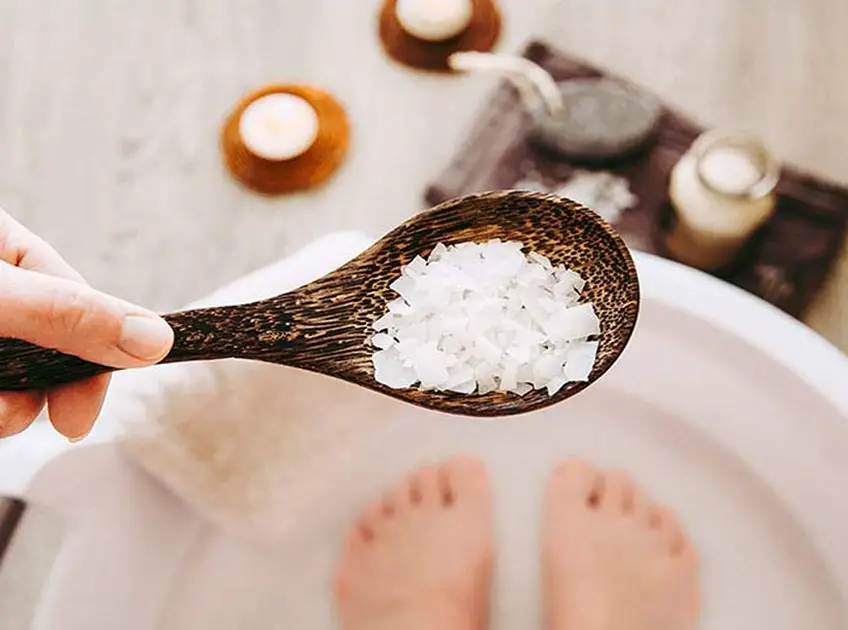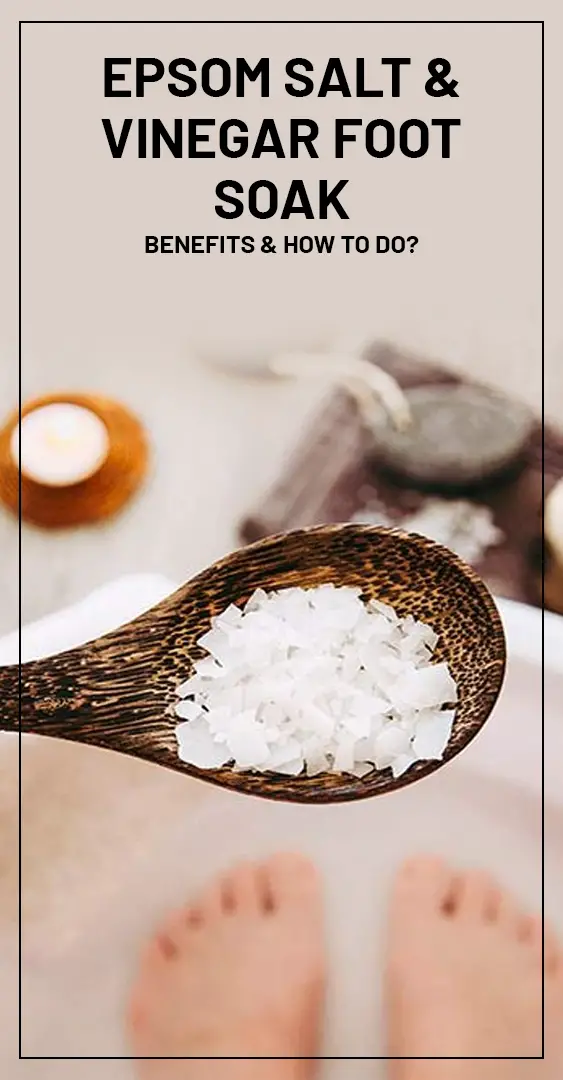
Important: This article is for informational purposes only. Please read our full disclaimer for more details.
Epsom salt and vinegar are two natural products that help combat different health issues. Generally, they are used to treat a variety of foot related complaints. They treat muscle aches, inflammation, and infections.
This article will discuss Epsom Salt and Vinegar Foot Soak methods and their benefits.
What Is Epsom Salt?
Epsom salt is a magnesium sulfate compound believed to have healing properties. It helps to treat infections and inflammations and upkeeps bone and nerve health.(1)
While magnesium in Epsom salt is considered mineral magic, sulfur has immense health-beneficial properties too. Soaking feet in an Epsom salt bath allows the skin to absorb magnesium, which could help treat various foot problems; however, more research is required to prove this claim.
Since there is a lack of research claiming the usefulness of Epsom salt for foot related complaints, the effects are believed to be placebo. Besides, it has been used traditionally for a long time, and people swear by its benefits.
What Is Vinegar?
Vinegar is a naturally-occurring liquid that contains many chemicals. It is approximately 5-20% acetic acid in water. Since acetic acid has strong antibacterial and antifungal properties, it protects against some microbes.(2)
A vinegar foot soak can help improve foot issues like foot odor, athlete’s foot, and warts. Since there are different types of vinegar, it is advised to use white vinegar for foot soak as it consists of 4 to 7% acetic acid (highest amongst all other types of vinegar).
How To Prepare Epsom Salt And Vinegar Foot Soak?
For easing soreness, infections, inflammations, and other foot related issues, the foot soak should be between 92°F and 100°F.
Now follow these steps to make the foot soak-
- Fill a big bucket or foot spa with warm water. Make sure the bucket is filled enough to cover the feet up to the ankles.
- Add half to three-quarters cup of Epsom salt and one cup of vinegar to the water.
- Dip your feet and soak them in this mixture for about 20 to 30 minutes.
- Dry the feet thoroughly and moisturize them.
Note:
- Since Epsom salt can dry the feet, it is advised to moisturize them properly after a foot soak. At the same time, perform this activity once or twice a week to make sure it does not cause dryness.
- You can add any essential oil with antibacterial, antifungal, and anti-inflammatory properties like clove oil, eucalyptus oil, lavender oil, etc., increasing the worth of this foot soak even more.
Precautions For Epsom Salt And Vinegar Foot Soak
Before you think about Epsom salt and vinegar foot soak, keep the following points handy-
- Make sure you purchase Epsom salt and vinegar intended for human use. Since these products are used for different purposes, they are available in different grades. So, check before you purchase.
- Look for vinegar and Epsom salt that have USP designated on the label. It will ensure that scientists have tested the product for human use and that it has met the safety regulations by FDA.
- Consult your healthcare provider before using Epsom salt and vinegar foot soak. It is because some people have dry skin and this foot soak that dry out the skin leaving the feet more prone to cracks.
- People with diabetes should not go for this foot soak as it increases the risk of infection. Soaking feet regularly in Epsom salt may make the skin dry, which leads to skin cracking and increased risk of infection.
- People with sores or open wounds should consult their doctor before using a foot soak.
Benefits Of Epsom Salt And Vinegar Foot Soak
Epsom salt has been used to treat various skin and ache-related complaints for a long time. It is believed to ease muscle soreness and infections.
While some studies claim that magnesium penetrates the skin, some say that it only penetrates the outer layer of the dermis and depends on the salt concentration and how long a person soaks in it.
Some major benefits that Epsom salt and vinegar foot soak provides are the following-
- Eases Inflammation- Epsom salt consists of magnesium and sulfur, which have anti-inflammatory properties. Their penetration inside the skin boosts the mineral level in the body and decreases inflammation. It eases the pain and stiffness associated with gout and arthritis.(3)
- Exfoliates Skin- It helps to exfoliate the dead skin on the feet and decrease roughness, making them feel softer.
- Reduces odor- Vinegar helps to clear the microbial biome on foot, the culprit behind foot odor. Also, it cleans up all bacterial and fungal infections.(4)
- Manages symptoms of athlete’s foot- Athlete’s foot is caused by fungus. While vinegar helps to clear the fungal infestation, Epsom salt helps draw the moisture out, making the environment less inviting for fungus.(5)
Final Words
Even though the research related to using Epsom salt and vinegar is limited, some indicate that the skin absorbs magnesium, reduces itching, decreases inflammation, and relieves soreness.
Just make sure that you consult your healthcare provider before using Epsom salt and vinegar foot soak to reduce the chances of excessive dryness, cracks, wounds, and infections.
You Might Also Like:
- How to Make a Apple Cider Vinegar Foot Soak?
- Can Potatoes in Your Socks Cure a Cold or Other Ailments?
- The 8 Best Homemade Foot Scrubs to Remove Dead Skin
- Coconut Oil for Feet – Why It’s Good for Your Feet?
- Epsom Salt Foot Soak – Benefits & How To Do It?
- Is Vinegar and Epsom Salt Good for Toenail Fungus?
- 5 DIY Foot Scrubs for Cracked Heels
- Listerine Foot Soak – Benefits
- Epsom Salt for Boils: 9 Ways to Use It
- Apple Cider Vinegar Bath: Benefits and How to Do?
- 7 Best Water Softener Salts For Sensitive Skin
















